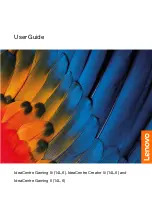
26
If still failing, the CPU is unable to read ROM or there is a component which is not
responding to a read or write by the CPU, probably the MFP 68901 or DMA
Controller. The MFP should respond to an MFPCS with DTACK. The DMA chip
should respond to FCS by asserting RDY. There is no way to check for a bad CPU
other than by elimination of the other two possibilities, although a hot CPU (too hot to
touch for more than a second) strongly indicates a bad CPU.
3.
If the CPU is not halted, it should be reading instructions from the ROM (cartridge, if
installed) and data and address lines will be toggling (if not, replace CPU). At this
point, there is the possibility that both the video and RS232 subsystems are failing.
Verify the output of the MFP chip (pin 8) while powering on the unit with the cartridge
installed. If the data is being sent, trace it through the 1488 driver. Note that ±12V is
required for RS232. If all looks good, there may be something wrong with the
connection to the terminal.
Verify also the output of the Video Shifter. If using an RGB monitor, check the
outputs to the summing resistors for R, G, and B. Note that if BLANK is not going
high, no picture will be output. If using monochrome, check the MONO output pin.
Also check the input to the MFP, pin 29, MONOMON. Note that if the CPU does not
read a low on this signal on power–up, it will cause RGB output on the Video Shifter
instead of MONO.
If the Video Shifter is outputting a signal, but the picture is unreadable, there is
probably a problem with the screen RAM. The cartridge should be used to diagnose
this problem, with the RS232 terminal as a display device.
3.4 STE DIAGNOSTIC CARTRIDGE
The STE Diagnostic Cartridge is used to detect and isolate component failures in STE
computers. This section gives a brief guide to its use with a description of each test, error
codes or passlfail criteria, and recommendations on repair.
3.5 POWER UP SEQUENCE
The diagnostic program performs several tests on power–up. The messages
“Checking
Exception
Handling”
and
"testing MFP, GSTMCU
timing, video”
will appear, and the
screen will appear scrambled for a few seconds before the menu is printed. The screen will
turn red (dark background in monochrome) if an error occurs in the initial testing, with a
message indicating the failure. The lowest 2 kbytes of RAM is tested on power–up; if a
location fails, the error will be printed to the RS232 device. It is assumed that if RAM is
failing, the screen may not be readable and program execution will fail because there are no
stack or system variables. The program will continue to test RAM and print errors, but no
screen will be displayed (the screen may turn red). Repair RAM.
If the keyboard fails, it will be inactivated. The user must connect a terminal to the RS232
port. The diagnostic program looks for keystrokes from the RS232 device.
If the display is unreadable, the RS232 terminal should be used. All messages are printed to
the RS232 port as well as on the screen.
Summary of Contents for 1040STE
Page 1: ......
Page 2: ...II Atari STe 520 1040 Computer Field Service Manual Part Number C302481 001 Rev A August 1991...
Page 23: ...18 Figure 2 8 STE Functional Block Diagram...
Page 24: ...19 Figure 2 9 STE DMA Block Diagram...
Page 28: ...23...
Page 53: ...48 Figure 6 1 STE Diagnostic Flow Chart...
Page 54: ...49 Figure 6 2 STE Diagnostic Flow Chart...
Page 55: ...50 Figure 6 3 STE Diagnostic Flow Chart...
Page 56: ...51 Figure 6 4 STE Diagnostic Flow Chart...
Page 72: ......
Page 73: ......
Page 74: ......
Page 75: ......
Page 76: ......
Page 77: ......
Page 78: ......
Page 79: ......
Page 80: ......
Page 81: ...ATARI STE TEST FIXTURE TO COMPUTER CONNECTION...
















































